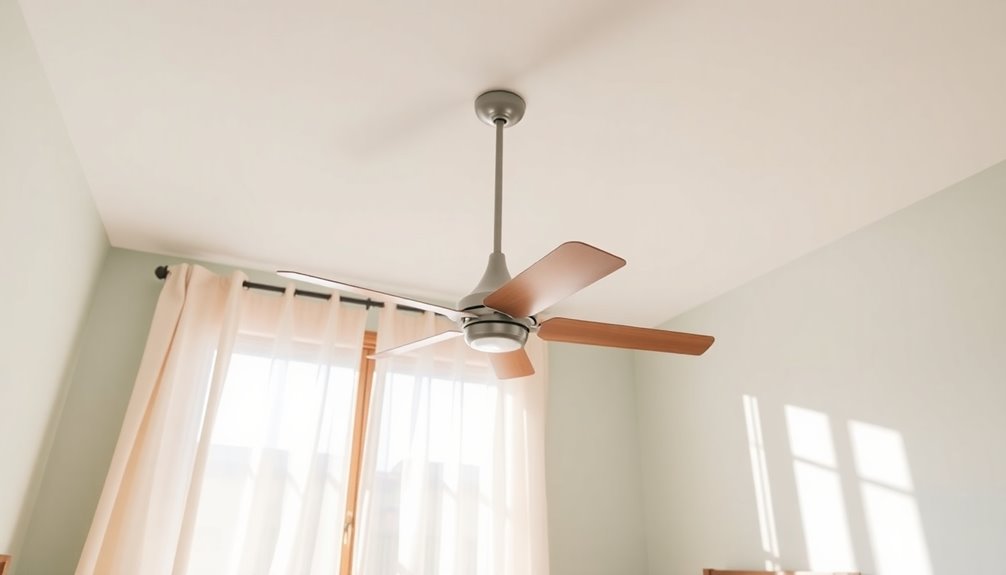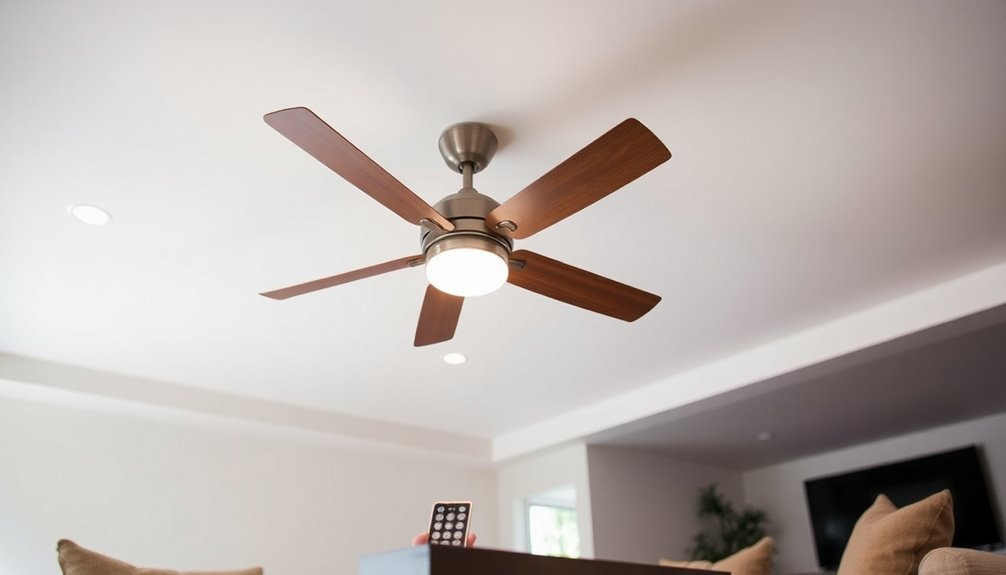Choosing the right ceiling fan size is essential for your comfort and air circulation. For rooms up to 75 sq. ft., a 29-36 inch fan works best. If your room is between 75 and 175 sq. ft., go for a 42-48 inch fan. Larger spaces, up to 350 sq. ft., will need a 52-56 inch fan. For areas over 350 sq. ft., choose fans larger than 60 inches. Measure your room and consider ceiling height and downrod length for peak performance. There's a lot more to learn about selecting the perfect fan for your space!
Key Takeaways
- Select a 29-36 inch fan for rooms up to 75 sq. ft. for optimal airflow and comfort.
- Choose a 42-48 inch fan for medium rooms between 75-175 sq. ft. to ensure effective air circulation.
- For large rooms (175-350 sq. ft.), a 52-56 inch fan is recommended to maintain comfort and efficiency.
- Fans over 60 inches are ideal for extra-large spaces exceeding 350 sq. ft. for adequate air movement.
- Always measure room dimensions accurately to select the appropriate fan size and ensure effective airflow.
Importance of Ceiling Fan Size

When you walk into a room, the ceiling fan's size can make a considerable difference in your comfort. Choosing the right ceiling fan size is essential for ideal air circulation, impacting both your comfort and energy efficiency.
If the fan is too small for the room's square footage, it won't circulate air effectively, leading to discomfort and increased utility bills. For instance, a 29-36 inch fan suits small rooms up to 75 sq. ft., while a fan over 60 inches is perfect for larger spaces exceeding 350 sq. ft.
The fan's blade span greatly affects its air movement capacity, measured in CFM (Cubic Feet per Minute). A higher CFM rating guarantees better airflow, especially in larger areas.
Proper fan sizing not only enhances the aesthetic balance of your room but also promotes energy savings. A correctly sized fan works harmoniously with your heating and cooling systems, allowing for efficient operation.
Measuring Room Dimensions

Choosing the right ceiling fan size starts with accurately measuring your room dimensions. Grab a tape measure and find the length and width of your room in feet. Multiply those numbers to calculate your total square footage, which is key for determining the appropriate ceiling fan size. For example, a 12 x 15-foot room equals 180 square feet, typically needing a fan between 42 to 48 inches in diameter for ideal airflow.
If your room isn't a perfect rectangle—like L-shaped rooms—divide the space into smaller rectangles. Measure each section, calculate their square footage, and sum the totals for an accurate measurement.
Don't forget to also consider your ceiling height and the downrod length, as these factors influence the fan's ideal height.
Selecting a ceiling fan that fits your room size enhances comfort and energy efficiency, particularly in larger spaces. Make sure you've got your measurements right before you shop for fans for large rooms, ensuring you create the perfect environment to keep cool and comfortable.
Recommended Fan Sizes by Room

When choosing a ceiling fan, room size plays an essential role in ensuring ideal airflow.
For small rooms up to 75 sq. ft., you'll want fans with a blade span of 29 to 36 inches, while larger spaces over 350 sq. ft. require fans that are 60 inches or wider.
Understanding these recommendations helps you select the right fan size for your comfort and energy efficiency.
Small Room Fan Sizes
Finding the right ceiling fan size for a small room can make a significant difference in comfort and airflow. For rooms measuring up to 75 square feet, you should choose a fan with a blade span of 29 to 36 inches. This size guarantees optimal airflow and energy efficiency, especially in compact spaces like small bathrooms or breakfast nooks.
If your small room is between 75 and 175 square feet, go for a fan with a blade span of 42 to 48 inches to effectively circulate air.
When selecting a ceiling fan, pay attention to the CFM (Cubic Feet per Minute) rating; aim for around 1,000 to 2,000 CFM for effective cooling and air movement.
Choosing the appropriate fan size is essential not only for enhancing comfort but also for preventing motor burnout and guaranteeing efficient operation in smaller areas.
A properly sized ceiling fan will keep your small room comfortable without wasting energy, making it a smart choice for your home.
Large Room Fan Sizes
For large rooms, selecting the right ceiling fan size is crucial to guarantee effective air circulation and comfort. If your space measures between 175 to 350 square feet, a large ceiling fan with a blade span of 52 to 56 inches is your best bet. This size guarantees ideal airflow, allowing you to enjoy comfortable cooling without wasting energy.
However, if you're dealing with rooms exceeding 350 square feet, you'll need a fan with a minimum diameter of 60 inches or larger. Larger fans are designed to move more air, which is important for maintaining a pleasant environment in spacious areas where air movement can be less efficient.
When choosing your ceiling fan, pay attention to the CFM (cubic feet per minute) rating. Higher CFM values will help ensure sufficient air movement, assuring that your large room stays cool and comfortable.
Ceiling Fan Blade Span

The blade span of a ceiling fan is vital for guaranteeing effective air circulation in your space. It refers to the diameter of the fan blades and plays an important role in determining the appropriate ceiling fan size for your room.
For small rooms (up to 75 sq. ft.), you'll want a fan with a blade span of 29 to 36 inches to achieve maximum airflow. In medium-sized rooms (75 to 175 sq. ft.), a span of 42 to 48 inches is recommended to enhance airflow efficiency.
When dealing with large rooms (175 to 350 sq. ft.), fans with a blade span of 52 to 56 inches are ideal. For extra-large spaces over 350 sq. ft., you should select a fan with a blade span of 60 inches or more.
Choosing the right blade span directly impacts airflow efficiency, which is measured in cubic feet per minute (CFM). Additionally, energy-efficient models are available, helping to reduce electricity costs while maintaining optimal airflow. By consulting a fan size guide, you can verify that your ceiling fan matches the room's dimensions, providing the comfort and circulation you desire.
Factors Affecting Airflow

When it comes to ceiling fans, several factors affect airflow and overall performance. The ceiling fan size, specifically the blade span, plays an essential role in determining its airflow capacity. Larger fans generally move more air, measured in CFM (cubic feet per minute), making them ideal for bigger rooms.
Blade pitch is another important factor; a higher pitch enhances air movement even at lower speeds, improving efficiency.
Your fan installation height matters too. Ideally, fans should be hung at least 7 feet above the floor to guarantee optimal circulation without creating a wind tunnel effect. Additionally, maintaining a distance of at least 12 inches from walls prevents airflow obstruction, allowing for effective circulation throughout the room.
Room size and layout considerably influence your choice of fan. For larger spaces, select fans with wider spans and higher CFM ratings to achieve the desired airflow.
Ceiling Fan Hanging Height

When it comes to ceiling fan hanging height, you'll want to make sure it's at least 7 feet above the floor for safety and ideal airflow.
If you've got higher ceilings, consider using longer downrods to bring the fan down to a more effective height.
Optimal Hanging Height
Hanging your ceiling fan at the right height is essential for ensuring both safety and effective airflow. Ideally, you want the blades to be about 8 feet above the floor for ideal airflow. This height offers a perfect balance between comfort and efficiency while ensuring proper fan clearance.
If your ceiling height exceeds the standard, a longer downrod length may be necessary to maintain effective air circulation.
Here are some key points to remember:
- Ceiling fans should be at least 7 feet above the floor to prevent accidents.
- Maintain a distance of at least 12 inches from walls for proper air circulation.
- For ceilings under 8 feet, consider low-profile fans or flush mount fans, though they may provide reduced airflow compared to downrod-mounted fans.
#
Downrod Length Considerations
Choosing the right downrod length is essential for ensuring your ceiling fan hangs at the ideal height for both airflow and safety. The downrod length plays a critical role in achieving peak airflow and maintaining proper fan clearance. For ceilings higher than 9 feet, using a downrod is often necessary to lower the fan to the recommended 8 feet above the floor.
Here's a quick reference table to guide your downrod length considerations:
| Ceiling Height | Recommended Downrod Length | Fan Clearance |
|---|---|---|
| 9 feet | 12 inches | 8 feet |
| 10 feet | 12 inches | 8 feet |
| 11 feet | 18 inches | 8 feet |
When you factor in the height of fan housings, which typically measure between 8 to 12 inches, it's important to adjust accordingly. Reference charts can help you determine the best downrod length for your specific ceiling height, ensuring proper fan installation. This way, you'll enjoy a well-ventilated space while keeping safety as a top priority.
## Downrod Length Considerations

Selecting the right downrod length is vital for guaranteeing your ceiling fan operates effectively and safely in higher rooms. When dealing with ceiling heights over 9 feet, using a downrod is important to achieve ideal airflow and maintain proper clearance.
For example, with a 10-foot ceiling, a 12-inch downrod is typically recommended to make sure the fan blades are at least 8 feet above the floor.
Consider these key points when determining downrod length:
- Clearance: Fan blades must be a minimum of 7 feet above the floor for safety.
- Airflow: Maintain at least 12 inches from walls to enhance airflow efficiency.
- Installation: Reference charts are available to guide you in selecting the recommended downrod lengths based on varying ceiling heights.
Motor Types and Efficiency

Understanding the motor types in ceiling fans can greatly impact your comfort and energy savings. When choosing a ceiling fan, consider the differences between AC and DC motors.
AC motors are commonly used and offer a cost-effective solution with three speed options. However, DC motors stand out for their energy efficiency and superior performance, often consuming up to 70% less energy than traditional AC motor fans. This makes them a sustainable choice for long-term use.
The efficiency of a ceiling fan is notably influenced by its motor type. DC motors typically provide better airflow capacity, measured in CFM (cubic feet per minute), ensuring you stay cool without excessive energy use.
Furthermore, modern ceiling fans equipped with DC motors often come with convenient features like remote controls and variable speed settings, allowing you to customize your comfort easily. Additionally, energy-efficient technology in ceiling fans can contribute to lower overall utility bills.
Ultimately, when selecting your ceiling fan, pay attention to the motor type. It directly impacts both the fan's performance and your potential energy savings over time, making it an essential factor in your decision-making process.
Installation and Maintenance Tips

Proper installation and maintenance are essential for guaranteeing your ceiling fan operates efficiently and safely. To get the best performance, follow the installation manual closely, as it provides vital safety information and step-by-step instructions.
When you install the ceiling fan, make sure it's at least 7 feet above the floor and maintains a minimum of 12 inches from the walls for ideal airflow. Additionally, choosing a fan with energy-efficient motors can further enhance performance and reduce electricity costs.
Here are a few tips to keep your fan running smoothly:
- Verify the downrod is the appropriate length for your ceiling height, providing a clearance of at least 8 feet from the floor to the fan blades.
- Regularly check and tighten screws to prevent wobbling and confirm the fan operates smoothly.
- Clean fan blades periodically with a damp cloth to remove dust and debris, which can hinder performance. Additionally, be aware that regular maintenance can prevent dangerous situations such as mechanical failures or loose components.
Frequently Asked Questions
Is a 52 Inch Fan Too Big for a 12X12 Room?
You might find that a 52-inch ceiling fan is indeed too big for your 12×12 room.
This size can create a "wind tunnel" effect, making the space feel drafty and uncomfortable.
Ideally, you should choose a fan with a blade span between 36 to 44 inches for better airflow.
This way, you'll enhance energy efficiency and guarantee a more comfortable environment without overpowering the room's scale.
How Big Should a Ceiling Fan Be?
When choosing a ceiling fan, you'll want to take into account the size of your room.
For small spaces up to 75 square feet, go for 29 to 36 inches.
Medium rooms, between 75 and 175 square feet, need fans that are 42 to 48 inches.
Large rooms, ranging from 175 to 350 square feet, should have fans of 52 to 56 inches.
For areas over 350 square feet, choose fans 60 inches or wider for ideal airflow.
Is a 42 Inch Fan Big Enough for a Bedroom?
Imagine stepping into a cool oasis after a long day—this is what a 42-inch ceiling fan can offer your bedroom.
Yes, it's big enough for spaces between 144 and 225 square feet, providing just the right airflow for comfort.
If your room's smaller, you might want to contemplate a 36-inch fan.
Just make sure it's hung at least 7 feet above the floor, allowing the invigorating breeze to dance freely around you.
What Size Room for a 52 Inch Ceiling Fan?
A 52-inch ceiling fan works best in rooms sized between 225 to 400 square feet.
If your space falls within this range, you'll enjoy ideal airflow and cooling efficiency.
For larger areas, like living rooms or open layouts, it can still circulate air effectively.
Just make sure to place it at least 7 feet above the floor and 12 inches away from walls to maximize airflow and comfort in your room.
Conclusion
Choosing the right ceiling fan size is essential—it can literally make or break your comfort level! Imagine a fan so perfectly sized that it transforms your room into an oasis of cool, gentle breezes. You'll feel like you've stepped into a luxurious resort every time you enter! So, don't skimp on those measurements; your ceiling fan should feel like a heavenly cloud dancing above you. Get it right, and you'll never want to leave your room again!









